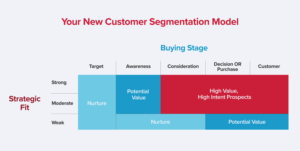This is post #5 in a 10-part series on the New B2B Marketing Paradigm.
In our last post, we discussed how to structure your team and processes towards high-quality content generation. In this post, we’ll talk about how best to segment your leads so you can nurture them strategically.
At Rivetica, we think of customer segmentation according to two key factors:
1) The strategic fit of the buyer. Are they in your core market or a less relevant industry? Are they at a company that would realistically be able to afford what you’re offering? This is where demographics or firmographics come in—for example: title, industry, company size and location.
Many marketers stop there. But, while these attributes are a helpful starting place, they can’t provide the full picture of someone’s propensity to purchase. Think about how many emails or LinkedIn messages you will get today about products that you have zero interest in or budget for. These messages are from folks relying solely on firmographics to segment their leads. But we’re suggesting that there’s another, equally important factor to consider:
2) The prospect’s location in the buying cycle. Are they just beginning to browse and at the beginning of a months-long process? Is this not on their radar at all? Or are they ready to make a purchase decision tomorrow?
Think about how many emails or LinkedIn messages you will get today about products that you have zero interest in or budget for. These messages are from folks relying solely on firmographics to segment their leads. But we’re suggesting that there’s another, equally important factor to consider.
With these two factors in mind, you can segment your leads like this:

In this chart, the Y-axis indicates a lead’s strategic fit, while the X-axis plots their position in the buying cycle. The shaded areas represent their current propensity to purchase, with blue being a “colder” lead, orange a “warmer” lead, and gray in between. (To build out this segmentation chart, you’ll need to lean on a combination of internal and external intent data. That’s where your marketing ops team comes in.)
Once you’ve plotted your prospects on this chart, you can tailor your demand-gen content to best nurture each lead. That means having a different messaging strategy for each color in the chart. During the “nurture” (or blue) stage, you’ll want to focus on educating the prospect about the business issues they need to solve. As someone moves into the “high value, high intent” (or warm) area, sharpen your content to be more specific to the solution you offer and how it is superior to the rest of the market.
Now that you know what types of content you need to create for whom, in our next post we’ll look at how to deploy your content across a mix of paid and free channels.
Stay tuned, and feel free to reach out in the meantime. We’d love to hear from you.
